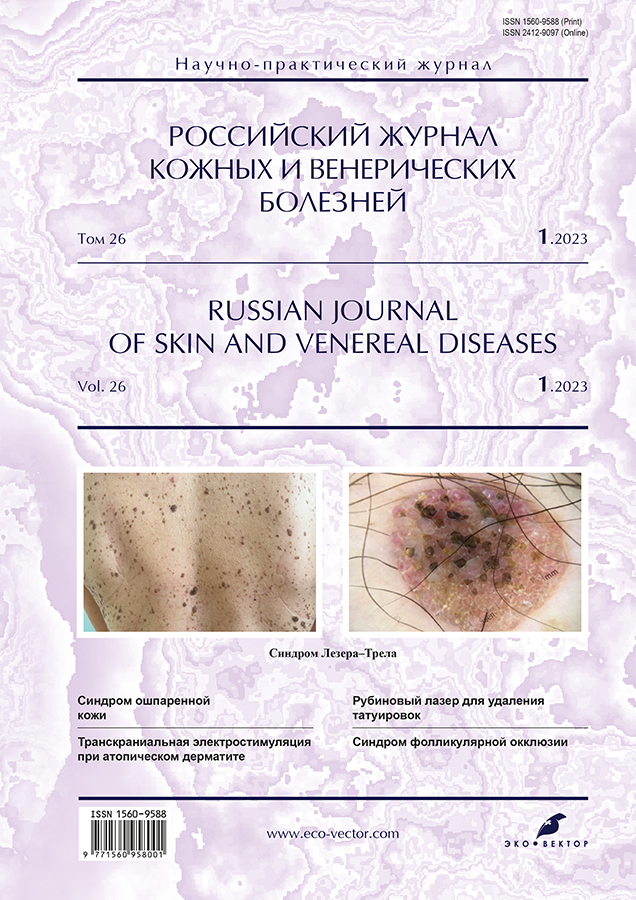Application of noninvasive hardware technique of transcranial electrical stimulation (TES) in patients with atopic dermatitis
- Authors: Kochergin N.G.1, Marchenko V.A.1
-
Affiliations:
- The First Sechenov Moscow State Medical University (Sechenov University)
- Issue: Vol 26, No 1 (2023)
- Pages: 73-78
- Section: DERMATOLOGY
- Submitted: 14.10.2022
- Accepted: 25.01.2023
- Published: 07.04.2023
- URL: https://rjsvd.com/1560-9588/article/view/111901
- DOI: https://doi.org/10.17816/dv111901
- ID: 111901
Cite item
Abstract
BACKGROUND: Transcranial electrostimulation (TES therapy) is a physiotherapeutic non-invasive technology that allows painlessly, selectively and strictly dosed activation of certain brain structures producing endogenous opioid peptides by modulating activity in these brain regions that are involved in the processing of pain and itching signals. Originally, this technique was used as an electronarcosis, then the scope of TES therapy in medicine expanded and began to be used in neurology, gynecology, urology, gastroenterology. The efficacy of its use in dermatology as an antipruritic action remain poorly understood.
AIM: the purpose of the pilot study was to evaluate the effectiveness and acceptability of the use of non-invasive TES therapy in patients with atopic dermatitis.
MATERIAL AND METHODS: According to the existing concept, itching is considered as a kind of pain sensation caused by an altered threshold level of nerve endings in the skin that perceive pain. Given this similarity of the mechanisms of pain and itching, noninvasive brain stimulation can simultaneously reduce itching, which opens up broad prospects for its further use in itchy dermatoses.
A pilot controlled study was conducted, the object of the study was patients with moderate atopic dermatitis (9 women and 6 men) aged 19 to 48 years. TES therapy was carried out by a pulsed bipolar electrical stimulator with acoustic effect "TRANSAIR-07" according to the standard method. All patients who received a course of TES monotherapy underwent 10 procedures, 1 time a day, lasting 30–40 minutes, with a current of 1–3 mA. To assess the dynamics of clinical manifestations of atopic dermatitis and the severity of the disease, the following scales were used: SCORAD, EASI, IGA, DLQI, HADS, BDI. The assessment was carried out twice: the first time on the day of diagnosis verification and again on the 10th day of treatment.
RESULTS: As a result of the treatment, there was a decrease in itching from 5 to 2 points, an improvement in mood from 5 to 1 point, an increase in performance from 4 to 1 point, a decrease in anxiety and depression from 4 to 2 points. With a general assessment of the dynamics of the indicators of the applied clinical scales (SCORAD, EASI, IGA, DLQI, HADS, BDI), the total average effectiveness in the form of parameter improvement amounted to 66.25% reduction by the end of the 10-day course.
CONCLUSION: The work presents the modern aspects of the application of non-invasive hardware transcranial electrical stimulation technique. The positive results of our own pilot study are presented and data confirming the clinical efficacy of transcranial electrical stimulation in patients with atopic dermatitis are presented, which determines the prospect of developing a combined application of TES therapy for this persistent disease.
Full Text
About the authors
Nikolay G. Kochergin
The First Sechenov Moscow State Medical University (Sechenov University)
Email: nkocha@yandex.ru
ORCID iD: 0000-0001-7136-4053
SPIN-code: 1403-3031
Scopus Author ID: 6602082412
MD, Dr. Sci. (Med.), Professor
Russian Federation, MoscowVioletta A. Marchenko
The First Sechenov Moscow State Medical University (Sechenov University)
Author for correspondence.
Email: vioshaka@mail.ru
ORCID iD: 0000-0001-9538-8893
SPIN-code: 5981-4242
Graduate Student
Russian Federation, MoscowReferences
- Bikson M, Esmaeilpour Z, Adair D, et al. Transcranial electrical stimulation nomenclatur. Brain Stimul. 2019;12(6):1349–1366. doi: 10.1016/j.brs.2019.07.010
- Kochergin HG, Afrikyan AA. Atopic dermatitis or eczema? Almanac Clin Med. 2007;(15):200–203. (In Russ).
- Olisova OY, Garanyan LG, Arsentyev NS. General aerocryotherapy in combination with UVB-311 nm narrow-band therapy for atopic dermatitis. Med Alphabet. 2019;1(7):60–62. (In Russ). doi: 10.33667/2078-5631-2019-1-7(382)-60-62
- Ivanov OL, Lvov AN, Michenko AV. Atopic dermatitis: modern views. Russ Med J. 2007;(19):1362–1366. (In Russ).
- Olisova OY. New opportunities in the treatment of atopic dermatitis. Russ J Skin Venereal Dis. 2015;18(6):38–41. (In Russ).
- Kochergin NG, Rumyanceva EE, Kondrashov GV, Traksel LV. Pimecrolimus in immunodermatoses. Russ Med J. 2003;11(17):953–956. (In Russ).
- Reynolds DV. Surgery in the rat during electrical analgesia induced by focal brain stimulation. Science. 1969;(164):444–445. doi: 10.1126/science.164.3878.444
- Lebedev VP, Sergienko VI. Development and justification of the therapeutic use of transcranial electrical stimulation of the protective mechanisms of the brain using the principles of evidence-based medicine (results of twenty years of research). In: Transcranial electrical stimulation: Experimental and clinical studies. Ed. by V.P. Lebedev Vol. 2. Saint Petersburg; 2005. Р. 11–69. (In Russ).
- Andreeva IN, Akishina IV. Transcranial electrostimulation. Astrakhan Med J. 2012;7(1):22–27. (In Russ).
- Knotkova H, Hamani C, Sivanesan E, et al. Neuromodulation for chronic pain. Lancet. 2021;397(10289):2111–2124. doi: 10.1016/S0140-6736(21)00794-7
- Iannone A, Allam N, Brasil-Neto JP. Safety of transcranial direct current stimulation in a patient with deep brain stimulation electrodes. Arq Neuropsiquiatr. 2019;77(3):174–178. doi: 10.1590/0004-282X20190019
Supplementary files








